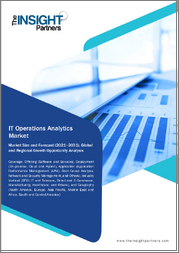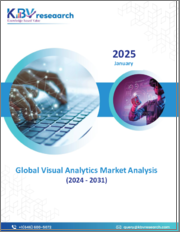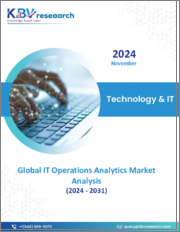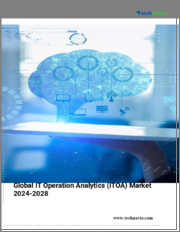
|
시장보고서
상품코드
1587717
세계의 IT 운영 분석 시장 예측 : 컴포넌트별, 전개 유형별, 분석 유형별, 조직 규모별, 최종 사용자별, 지역별 분석(-2030년)IT Operations Analytics (ITOA) Market Forecasts to 2030 - Global Analysis By Component (Solution and Services), Deployment Type (On-Premise and Cloud-Based), Analytics Type, Organization Size, End User and By Geography |
||||||
Stratistics MRC에 따르면 세계의 IT 운영 분석 시장은 2024년 263억 달러로 추정되고, 예측 기간 동안 CAGR은 34.2%로 성장할 전망이며, 2030년에는 1,536억 달러에 이를 것으로 예측됩니다.
데이터 분석 툴과 기술의 활용에 의한 IT 시스템이나 인프라의 모니터링, 관리, 최적화는 IT 운영 분석으로 알려져 있습니다. 대량의 운영 데이터를 실시간으로 수집하고 분석함으로써 IT 운영 분석은 발생할 수 있는 장애 예측, 성능 질문 주제 식별, 보안 향상 및 IT 전반의 효율성을 지원합니다. 다양한 산업 분야에서 IT 운영 분석은 사전 활동적인 의사 결정을 촉진하고 자동화를 촉진하며 리소스를 최적화하는 인사이트를 제공하며 더 효율적인 IT 운영과 더 나은 성과를 보장합니다.
IDC에 따르면 2022년 클라우드 IT 인프라에 대한 지출은 전 세계에서 전년 대비 12.5% 증가한 약 900억 달러에 달한다고 합니다.
복잡한 IT 환경
클라우드 컴퓨팅, 마이크로서비스, 분산 시스템의 채택으로 IT 환경이 복잡해지고 있는 것은 IT 운영 분석 시장의 주요 촉진요인이 되고 있습니다. 조직이 민첩성과 확장성을 높이기 위해 이러한 기술을 채택함에 따라 이러한 복잡한 환경을 모니터링, 관리 및 최적화하기 위한 고도의 분석 솔루션의 필요성이 매우 중요해지고 있습니다. IT 운영 분석 툴은 IT팀이 시스템의 성능과 건전성을 실시간으로 가시화하고 문제를 프로액티브로 파악해 해결하며 리소스의 최적의 사용을 보장하고 전체 IT 효율성을 향상시키는 데 도움이 됩니다.
높은 도입 비용
IT 운영 분석 솔루션과 관련된 높은 도입 비용은 시장 성장의 억제요인이 될 수 있습니다. IT 운영 분석 툴을 기존의 IT인프라에 도입·통합하려면 하드웨어, 소프트웨어, 숙련된 인재에 대한 고액의 선행투자가 필요한 많은 경우가 있습니다. 또한 지속적인 유지 보수, 업데이트 및 교육의 필요성은 총 소유 비용을 더욱 높일 수 있습니다. 이러한 비용은, IT 예산이 한정되어 있는 중소기업에 있어서는 장벽이 되어, IT 운영 분석 솔루션의 보급을 방해하고 있습니다.
인공지능 및 머신러닝 확대
AI 및 ML 알고리즘을 활용함으로써 IT 운영 분석 솔루션은 방대한 양의 데이터를 실시간으로 분석하고 패턴을 파악하고 예측 인사이트를 제공할 수 있습니다. 이를 통해 IT팀은 이상 감지, 근본 원인 분석, 사고 대응을 자동화하고 수작업을 줄여 전반적인 효율성을 높일 수 있습니다. AI 및 ML의 기능이 계속 진화함에 따라 IT 운영 분석 솔루션은 더욱 정교해지고 기업은 IT 운영을 최적화하고 비즈니스 가치를 높일 수 있습니다.
사이버 보안 위험
IT 운영 분석 솔루션에 대한 의존도가 높아짐에 따라 조직은 잠재적인 사이버 보안 위험에 노출될 것입니다. IT 운영 분석 툴은 다양한 IT 시스템에서 기밀 데이터를 수집하고 분석하기 때문에 이러한 솔루션에 취약성과 위반으로 인해 IT 인프라 전반의 보안이 위협받을 수 있습니다. 사이버 범죄자는 IT 운영 분석 시스템을 표적으로 중요 데이터에 대한 부정 액세스나 IT 운용을 방해할 가능성이 있어 전체적으로 시장 성장에 영향을 미칩니다.
COVID-19의 영향 :
COVID-19의 대유행은 조직이 원격 근무와 디지털 업무로 빠르게 이동했기 때문에 IT 운영 분석 솔루션의 채택을 가속화했습니다. 클라우드 기반 서비스에 대한 의존도가 높아지면서 IT 인프라의 원격 모니터링 및 관리에 대한 필요성이 IT 운영 분석 도구의 중요성을 강조했습니다. 그러나 팬데믹에 기인한 경제 불확실성도 예산 제약으로 이어지고 있으며, IT 운영 분석 시장의 성장이 일시적으로 둔화될 수 있습니다.
예측 기간 동안 클라우드 기반 부문이 최대가 될 것으로 전망
모든 규모의 조직에서 클라우드 컴퓨팅의 도입이 진행되고 있으며, 예측 기간 동안 클라우드 기반 부문이 최대 시장 점유율을 확보할 것으로 예측됩니다. 클라우드 기반 IT 운영 분석 솔루션은 확장성, 유연성 및 비용 효율성을 제공하므로 기업은 하드웨어와 인프라에 상당한 선행 투자 없이 IT 운영을 모니터링하고 관리할 수 있습니다. 종량 과금의 가격 모델과 어디서나 IT 운영 분석 기능에 액세스할 수 있다는 것이 이 부문의 성장을 더욱 향상시킵니다.
예측 기간 동안 CAGR은 처방적 분석 부문이 가장 높을 것으로 예상됩니다.
처방적 분석 부문은 예측 기간 동안 상당한 성장을 이룰 것으로 예상됩니다. 처방적 분석은 IT 운영을 최적화하기 위한 실행 가능한 권장사항을 제공함으로써 기술적 분석 및 예측 분석을 초과합니다. 과거 데이터, 실시간 성과 지표, 비즈니스 목표를 분석함으로써, 처방적 분석은 IT 팀이 데이터 중심의 의사 결정을 내리고, 자원 배분 개선, 잠재적 문제 방지, IT 운영 및 조직 목표 무결성을 도모하는 데 도움이 됩니다. 조직이 IT 프로세스의 자동화 및 최적화를 목표로 하는 동안 IT 운영 분석 솔루션의 처방적 분석 기능에 대한 수요는 크게 확대될 것으로 예상됩니다.
최대 점유율을 차지하는 지역 :
북미는 선진 기술의 조기 도입과 주요 시장 기업의 존재감의 강도로 IT 운영 분석 시장에서 주도권을 유지할 것으로 예상됩니다. 이 지역의 탄탄한 IT 인프라와 분석 툴에 대한 투자 증가로 기업은 복잡한 IT 환경을 효과적으로 관리할 수 있게 되었습니다. 또한, 업무 효율의 향상과 사이버 보안 대책에 대한 주목이 높아지고 있는 것도, 북미가 IT 운영 분석 솔루션의 최대 시장인 것을 더욱 확고히 하고 있습니다.
CAGR이 가장 높은 지역 :
아시아태평양은 급속한 디지털 전환과 클라우드 기술의 채용 증가로 예측 기간 동안 가장 높은 CAGR을 나타낼 것으로 예측됩니다. 이 지역 기업들은 효율성과 경쟁력 강화에 있어 IT 운영 분석의 가치를 인식하고 IT 운영 분석 솔루션에 대한 수요가 급증하고 있습니다. 또한 정부 지원 및 IT 인프라에 대한 투자가이 지역의 성장에 기여하고 있으며 세계 IT 운영 분석 시장에서 중요한 기업으로 자리매김하고 있습니다.
무료 주문을 받아서 만드는 서비스 :
이 보고서를 구독하는 고객은 다음 무료 맞춤설정 옵션 중 하나를 사용할 수 있습니다.
- 기업 프로파일
- 추가 시장 기업의 종합적 프로파일링(3개사까지)
- 주요 기업의 SWOT 분석(3개사까지)
- 지역 세분화
- 고객의 관심에 응한 주요국 시장 추계, 예측 및 CAGR(주 : 타당성 확인에 따름)
- 경쟁 벤치마킹
- 제품 포트폴리오, 지리적 존재, 전략적 제휴에 기반한 주요 기업 벤치마킹
목차
제1장 주요 요약
제2장 서문
- 개요
- 이해관계자
- 조사 범위
- 조사 방법
- 데이터 마이닝
- 데이터 분석
- 데이터 검증
- 조사 접근
- 조사 정보원
- 1차 조사 정보원
- 2차 조사 정보원
- 전제조건
제3장 시장 동향 분석
- 성장 촉진요인
- 억제요인
- 기회
- 위협
- 최종 사용자 분석
- 신흥 시장
- COVID-19의 영향
제4장 Porter's Five Forces 분석
- 공급기업의 협상력
- 구매자의 협상력
- 대체품의 위협
- 신규 진입업자의 위협
- 경쟁 기업간 경쟁 관계
제5장 세계의 IT 운영 분석 시장 : 컴포넌트별
- 해결
- 로그 관리
- 용도 성능 관리
- 근본 원인 분석
- 예측 분석
- 비용 관리
- 네트워크 및 보안 관리
- 서비스
- 전문 서비스
- 컨설팅
- 구현 및 통합
- 지원 및 유지 보수
- 매니지드 서비스
- 전문 서비스
제6장 세계의 IT 운영 분석 시장 : 전개 유형별
- 온프레미스
- 클라우드 기반
제7장 세계의 IT 운영 분석 시장 : 분석 유형별
- 기술적 분석
- 진단 분석
- 예측 분석
- 처방적 분석
제8장 세계의 IT 운영 분석 시장 : 조직 규모별
- 중소기업
- 대기업
제9장 세계의 IT 운영 분석 시장 : 최종 사용자별
- 은행/금융서비스/보험(BFSI)
- 소매 및 전자상거래
- 헬스케어
- IT 및 통신
- 제조업
- 정부 및 공공 부문
- 에너지 및 유틸리티
- 기타 최종 사용자
제10장 세계의 IT 운영 분석 시장 : 지역별
- 북미
- 미국
- 캐나다
- 멕시코
- 유럽
- 독일
- 영국
- 이탈리아
- 프랑스
- 스페인
- 기타 유럽
- 아시아태평양
- 일본
- 중국
- 인도
- 호주
- 뉴질랜드
- 한국
- 기타 아시아태평양
- 남미
- 아르헨티나
- 브라질
- 칠레
- 기타 남미
- 중동 및 아프리카
- 사우디아라비아
- 아랍에미리트(UAE)
- 카타르
- 남아프리카
- 기타 중동 및 아프리카
제11장 주요 발전
- 계약, 파트너십, 협업 및 합작 투자
- 인수 및 합병
- 신제품 발매
- 사업 확대
- 기타 주요 전략
제12장 기업 프로파일링
- Splunk Inc.
- IBM Corporation
- Microsoft Corporation
- Oracle Corporation
- SAP SE
- BMC Software, Inc.
- Cisco Systems, Inc.
- Hewlett Packard Enterprise Development LP
- Micro Focus International plc
- Dynatrace LLC
- Broadcom Inc.
- VMware, Inc.
- ExtraHop Networks, Inc.
- Datadog, Inc.
- SolarWinds Corporation
- New Relic, Inc.
- Sumo Logic, Inc.
According to Stratistics MRC, the Global IT Operations Analytics (ITOA) Market is accounted for $26.3 billion in 2024 and is expected to reach $153.6 billion by 2030, growing at a CAGR of 34.2% during the forecast period. Monitoring, managing, and optimizing IT systems and infrastructure through the use of data analytics tools and techniques is known as IT Operations Analytics (ITOA). Through real-time collection and analysis of massive volumes of operational data, ITOA assists organizations in predicting possible failures, identifying performance issues, improving security, and increasing overall IT efficiency. In a variety of industries, it facilitates proactive decision-making, facilitates automation, and offers insights to optimize resources, guaranteeing more efficient IT operations and better business results.
According to IDC, worldwide spending on cloud IT infrastructure grew by 12.5% year-over-year in 2022, reaching approximately $90 billion.
Market Dynamics:
Driver:
Increasing complexity of IT environments
The growing complexity of IT environments, driven by the adoption of cloud computing, microservices, and distributed systems, is a significant driver for the IT Operations Analytics (ITOA) market. As organizations embrace these technologies to enhance agility and scalability, the need for advanced analytics solutions to monitor, manage, and optimize these complex environments becomes crucial. ITOA tools help IT teams gain real-time visibility into the performance and health of their systems, enabling them to proactively identify and resolve issues, ensure optimal resource utilization, and improve overall IT efficiency.
Restraint:
High implementation costs
The high implementation costs associated with ITOA solutions can be a restraint for market growth. Deploying and integrating ITOA tools into existing IT infrastructures often requires significant upfront investments in hardware, software, and skilled personnel. Additionally, the need for ongoing maintenance, updates, and training further adds to the total cost of ownership. These costs can be a barrier for small and medium-sized enterprises with limited IT budgets, hindering the widespread adoption of ITOA solutions.
Opportunity:
Expansion of artificial intelligence and machine learning
By leveraging AI and ML algorithms, ITOA solutions can analyze vast amounts of data in real-time, identify patterns, and provide predictive insights. This enables IT teams to automate anomaly detection, root cause analysis, and incident response, reducing manual intervention and improving overall efficiency. As AI and ML capabilities continue to evolve, ITOA solutions will become more sophisticated, enabling organizations to optimize their IT operations and drive business value.
Threat:
Cybersecurity risks
The increasing reliance on ITOA solutions also exposes organizations to potential cybersecurity risks. As ITOA tools collect and analyze sensitive data from various IT systems, any vulnerabilities or breaches in these solutions can compromise the security of the entire IT infrastructure. Cybercriminals may target ITOA systems to gain unauthorized access to critical data or disrupt IT operations, which overall affect the market growth.
Covid-19 Impact:
The COVID-19 pandemic has accelerated the adoption of ITOA solutions as organizations rapidly shifted to remote work and digital operations. The increased reliance on cloud-based services and the need for remote monitoring and management of IT infrastructure have highlighted the importance of ITOA tools. However, the economic uncertainties caused by the pandemic have also led to budget constraints, which may temporarily slow down the growth of the ITOA market.
The cloud-based segment is expected to be the largest during the forecast period
Organizations of all sizes are increasingly adopting cloud computing, predicting the cloud-based segment to secure the largest market share throughout the forecast period. Cloud-based ITOA solutions offer scalability, flexibility, and cost-effectiveness, enabling organizations to monitor and manage their IT operations without significant upfront investments in hardware and infrastructure. The pay-as-you-go pricing model and the ability to access ITOA capabilities from anywhere further drive the growth of this segment.
The prescriptive analytics segment is expected to have the highest CAGR during the forecast period
The prescriptive analytics segment is projected to witness substantial growth during the projection period. Prescriptive analytics goes beyond descriptive and predictive analytics by providing actionable recommendations to optimize IT operations. By analyzing historical data, real-time performance metrics, and business objectives, prescriptive analytics helps IT teams make data-driven decisions to improve resource allocation, prevent potential issues, and align IT operations with organizational goals. As organizations seek to automate and optimize their IT processes, the demand for prescriptive analytics capabilities in ITOA solutions is expected to grow significantly.
Region with largest share:
The North America region is expected to maintain its leadership in the IT operations analytics market due to its early adoption of advanced technologies and strong presence of key market players. The region's robust IT infrastructure, coupled with increasing investments in analytics tools, enables organizations to effectively manage complex IT environments. Additionally, the growing focus on enhancing operational efficiency and cybersecurity measures further solidifies North America's position as the largest market for ITOA solutions.
Region with highest CAGR:
The Asia Pacific region is anticipated to experience the highest CAGR during the forecast period, driven by rapid digital transformation and increasing adoption of cloud technologies. As organizations in this region recognize the value of IT operations analytics in enhancing efficiency and competitiveness, the demand for ITOA solutions is surging. Furthermore, supportive government initiatives and investments in IT infrastructure contribute to the region's growth, positioning it as a significant player in the global ITOA market.
Key players in the market
Some of the key players in IT Operations Analytics (ITOA) Market include Splunk Inc., IBM Corporation, Microsoft Corporation, Oracle Corporation, SAP SE, BMC Software, Inc., Cisco Systems, Inc., Hewlett Packard Enterprise Development LP, Micro Focus International plc, Dynatrace LLC, Broadcom Inc., VMware, Inc., ExtraHop Networks, Inc., Datadog, Inc., SolarWinds Corporation, New Relic, Inc., and Sumo Logic, Inc.
Key Developments:
In May 2024, IBM announced several new updates to its WatsonX platform, including open-sourced models, AI capabilities to improve business processes, and a focus on open-source innovation during its annual THINK conference. They introduced the Granite 3.0 models, which are open-source and designed to enhance AI integration in enterprise environments.
In October 2023, BMC Software, Inc. has embedded generative AI capabilities into its entire AI-driven service and operations management portfolio, claiming the title of the first vendor in the industry to do so. The BMC HelixGPT solution offers improved incident resolution, enabling enterprises to recover faster from outages and providing actionable insights.
In March 2023, Hewlett Packard Enterprise (HPE) announced its acquisition of OpsRamp, an IT operations management (ITOM) company, to enhance its hybrid cloud capabilities and streamline operations across multi-vendor IT environments. This acquisition aims to improve the management of IT infrastructure and cloud resources, reducing operational complexity for customers.
Components Covered:
- Solution
- Services
Deployment Types Covered:
- On-Premise
- Cloud-Based
Analytics Types Covered:
- Descriptive Analytics
- Diagnostic Analytics
- Predictive Analytics
- Prescriptive Analytics
Organization Sizes Covered:
- Small and Medium-Sized Enterprises (SMEs)
- Large Enterprises
End Users Covered:
- Banking, Financial Services, and Insurance (BFSI)
- Retail & E-commerce
- Healthcare
- IT & Telecom
- Manufacturing
- Government & Public Sector
- Energy & Utilities
- Other End Users
Regions Covered:
- North America
- US
- Canada
- Mexico
- Europe
- Germany
- UK
- Italy
- France
- Spain
- Rest of Europe
- Asia Pacific
- Japan
- China
- India
- Australia
- New Zealand
- South Korea
- Rest of Asia Pacific
- South America
- Argentina
- Brazil
- Chile
- Rest of South America
- Middle East & Africa
- Saudi Arabia
- UAE
- Qatar
- South Africa
- Rest of Middle East & Africa
What our report offers:
- Market share assessments for the regional and country-level segments
- Strategic recommendations for the new entrants
- Covers Market data for the years 2022, 2023, 2024, 2026, and 2030
- Market Trends (Drivers, Constraints, Opportunities, Threats, Challenges, Investment Opportunities, and recommendations)
- Strategic recommendations in key business segments based on the market estimations
- Competitive landscaping mapping the key common trends
- Company profiling with detailed strategies, financials, and recent developments
- Supply chain trends mapping the latest technological advancements
Free Customization Offerings:
All the customers of this report will be entitled to receive one of the following free customization options:
- Company Profiling
- Comprehensive profiling of additional market players (up to 3)
- SWOT Analysis of key players (up to 3)
- Regional Segmentation
- Market estimations, Forecasts and CAGR of any prominent country as per the client's interest (Note: Depends on feasibility check)
- Competitive Benchmarking
- Benchmarking of key players based on product portfolio, geographical presence, and strategic alliances
Table of Contents
1 Executive Summary
2 Preface
- 2.1 Abstract
- 2.2 Stake Holders
- 2.3 Research Scope
- 2.4 Research Methodology
- 2.4.1 Data Mining
- 2.4.2 Data Analysis
- 2.4.3 Data Validation
- 2.4.4 Research Approach
- 2.5 Research Sources
- 2.5.1 Primary Research Sources
- 2.5.2 Secondary Research Sources
- 2.5.3 Assumptions
3 Market Trend Analysis
- 3.1 Introduction
- 3.2 Drivers
- 3.3 Restraints
- 3.4 Opportunities
- 3.5 Threats
- 3.6 End User Analysis
- 3.7 Emerging Markets
- 3.8 Impact of Covid-19
4 Porters Five Force Analysis
- 4.1 Bargaining power of suppliers
- 4.2 Bargaining power of buyers
- 4.3 Threat of substitutes
- 4.4 Threat of new entrants
- 4.5 Competitive rivalry
5 Global IT Operations Analytics (ITOA) Market, By Component
- 5.1 Introduction
- 5.2 Solution
- 5.2.1 Log Management
- 5.2.2 Application Performance Management
- 5.2.3 Root Cause Analysis
- 5.2.4 Predictive Analytics
- 5.2.5 Cost Management
- 5.2.6 Network and Security Management
- 5.3 Services
- 5.3.1 Professional Services
- 5.3.1.1 Consulting
- 5.3.1.2 Implementation & Integration
- 5.3.1.3 Support & Maintenance
- 5.3.2 Managed Services
- 5.3.1 Professional Services
6 Global IT Operations Analytics (ITOA) Market, By Deployment Type
- 6.1 Introduction
- 6.2 On-Premise
- 6.3 Cloud-Based
7 Global IT Operations Analytics (ITOA) Market, By Analytics Type
- 7.1 Introduction
- 7.2 Descriptive Analytics
- 7.3 Diagnostic Analytics
- 7.4 Predictive Analytics
- 7.5 Prescriptive Analytics
8 Global IT Operations Analytics (ITOA) Market, By Organization Size
- 8.1 Introduction
- 8.2 Small and Medium-Sized Enterprises (SMEs)
- 8.3 Large Enterprises
9 Global IT Operations Analytics (ITOA) Market, By End User
- 9.1 Introduction
- 9.2 Banking, Financial Services, and Insurance (BFSI)
- 9.3 Retail & E-commerce
- 9.4 Healthcare
- 9.5 IT & Telecom
- 9.6 Manufacturing
- 9.7 Government & Public Sector
- 9.8 Energy & Utilities
- 9.9 Other End Users
10 Global IT Operations Analytics (ITOA) Market, By Geography
- 10.1 Introduction
- 10.2 North America
- 10.2.1 US
- 10.2.2 Canada
- 10.2.3 Mexico
- 10.3 Europe
- 10.3.1 Germany
- 10.3.2 UK
- 10.3.3 Italy
- 10.3.4 France
- 10.3.5 Spain
- 10.3.6 Rest of Europe
- 10.4 Asia Pacific
- 10.4.1 Japan
- 10.4.2 China
- 10.4.3 India
- 10.4.4 Australia
- 10.4.5 New Zealand
- 10.4.6 South Korea
- 10.4.7 Rest of Asia Pacific
- 10.5 South America
- 10.5.1 Argentina
- 10.5.2 Brazil
- 10.5.3 Chile
- 10.5.4 Rest of South America
- 10.6 Middle East & Africa
- 10.6.1 Saudi Arabia
- 10.6.2 UAE
- 10.6.3 Qatar
- 10.6.4 South Africa
- 10.6.5 Rest of Middle East & Africa
11 Key Developments
- 11.1 Agreements, Partnerships, Collaborations and Joint Ventures
- 11.2 Acquisitions & Mergers
- 11.3 New Product Launch
- 11.4 Expansions
- 11.5 Other Key Strategies
12 Company Profiling
- 12.1 Splunk Inc.
- 12.2 IBM Corporation
- 12.3 Microsoft Corporation
- 12.4 Oracle Corporation
- 12.5 SAP SE
- 12.6 BMC Software, Inc.
- 12.7 Cisco Systems, Inc.
- 12.8 Hewlett Packard Enterprise Development LP
- 12.9 Micro Focus International plc
- 12.10 Dynatrace LLC
- 12.11 Broadcom Inc.
- 12.12 VMware, Inc.
- 12.13 ExtraHop Networks, Inc.
- 12.14 Datadog, Inc.
- 12.15 SolarWinds Corporation
- 12.16 New Relic, Inc.
- 12.17 Sumo Logic, Inc.



















